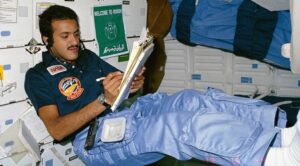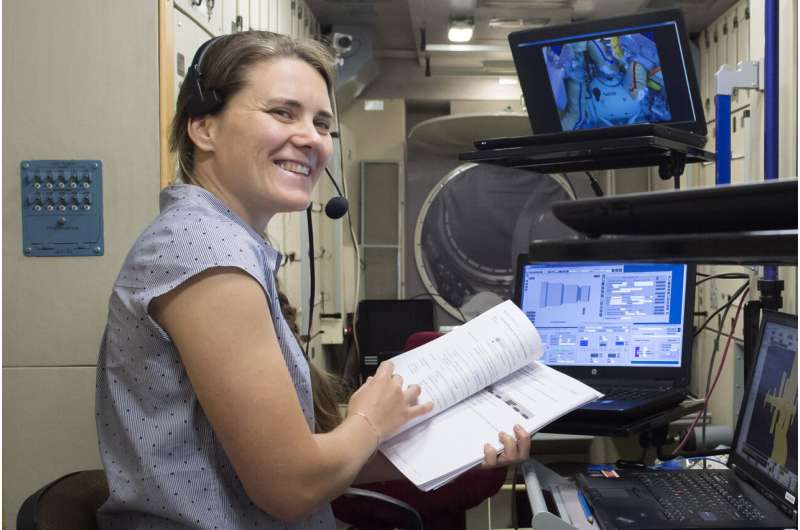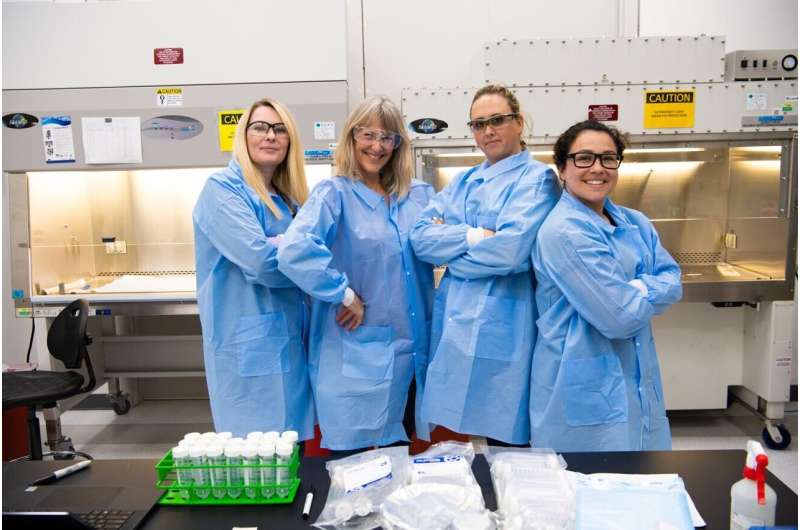Dragon docks at ISS to deliver various science payloads
Saturday, 16 July 2022 23:50 While the International Space Station was traveling more than 267 miles over the South Atlantic Ocean, the SpaceX Dragon cargo spacecraft autonomously docked to the forward-facing port of the station's Harmony module at 11:21 a.m. EDT Jul 17, with NASA astronauts Bob Hines and Jessica Watkins monitoring operations from the station.
The Dragon launched on SpaceX's 25th contracted commercial
While the International Space Station was traveling more than 267 miles over the South Atlantic Ocean, the SpaceX Dragon cargo spacecraft autonomously docked to the forward-facing port of the station's Harmony module at 11:21 a.m. EDT Jul 17, with NASA astronauts Bob Hines and Jessica Watkins monitoring operations from the station.
The Dragon launched on SpaceX's 25th contracted commercial Ingenuity Postpones Flights Until August
Saturday, 16 July 2022 23:50 It's now dust season and winter on Mars, meaning there's more dust in the air and less sunlight to help recharge Ingenuity's batteries. Dust levels are expected to subside later in July, so the team has decided to give the helicopter's batteries a break for a few weeks and build their daily state of charge back up. Weather permitting, Ingenuity is expected to be back in the air around the start
It's now dust season and winter on Mars, meaning there's more dust in the air and less sunlight to help recharge Ingenuity's batteries. Dust levels are expected to subside later in July, so the team has decided to give the helicopter's batteries a break for a few weeks and build their daily state of charge back up. Weather permitting, Ingenuity is expected to be back in the air around the start A Rover-Sized Boulder Sols 3532-3533
Saturday, 16 July 2022 23:50 Curiosity is back on the road, but some interesting boulders caught our attention and led to a short detour. The team was already planning to divert to the southwest to get some imaging of nearby cliffs, but the large boulders that have tumbled down provide a tantalizing glimpse of what's to come.
Boulders like the large one shown in the above Navcam image (now named "Ilha Novo Destino") c
Curiosity is back on the road, but some interesting boulders caught our attention and led to a short detour. The team was already planning to divert to the southwest to get some imaging of nearby cliffs, but the large boulders that have tumbled down provide a tantalizing glimpse of what's to come.
Boulders like the large one shown in the above Navcam image (now named "Ilha Novo Destino") c Rocking shadows in protoplanetary discs
Saturday, 16 July 2022 23:50 Astronomers from the University of Warwick reveal a new phenomenon dubbed the "rocking shadow" effect that describes how discs in forming planetary systems are oriented, and how they move around their host star. The effect also gives clues as to how they might evolve with time. Dr Rebecca Nealon presented the new work this week at the 2022 National Astronomy Meeting at the University of Warwick.
Astronomers from the University of Warwick reveal a new phenomenon dubbed the "rocking shadow" effect that describes how discs in forming planetary systems are oriented, and how they move around their host star. The effect also gives clues as to how they might evolve with time. Dr Rebecca Nealon presented the new work this week at the 2022 National Astronomy Meeting at the University of Warwick. Cyborg collaboration finds 40,000 ring galaxies
Saturday, 16 July 2022 23:50 Human and machine intelligence worked together to find 40,000 ring galaxies, scientists at the National Astronomy Meeting will announce this week. Dr Mike Walmsley of the University of Manchester and the Galaxy Zoo collaboration will present the new work, describing how this "cyborg" approach measured the shapes of millions of galaxies.
Galaxies live a chaotic life. Collisions with other g
Human and machine intelligence worked together to find 40,000 ring galaxies, scientists at the National Astronomy Meeting will announce this week. Dr Mike Walmsley of the University of Manchester and the Galaxy Zoo collaboration will present the new work, describing how this "cyborg" approach measured the shapes of millions of galaxies.
Galaxies live a chaotic life. Collisions with other g Neutrino Factories in Deep Outer Space
Saturday, 16 July 2022 23:50 The Earth's atmosphere is continuously bombarded by cosmic rays. These consist of electrically charged particles of energies up to 1020 electron volts. That is a million times more than the energy achieved in the world's most powerful particle accelerator, the Large Hadron Collider near Geneva.
The extremely energetic particles come from deep outer space, they have travelled billions of li
The Earth's atmosphere is continuously bombarded by cosmic rays. These consist of electrically charged particles of energies up to 1020 electron volts. That is a million times more than the energy achieved in the world's most powerful particle accelerator, the Large Hadron Collider near Geneva.
The extremely energetic particles come from deep outer space, they have travelled billions of li Astrophysicists prove neutrinos originate from Blazars
Saturday, 16 July 2022 23:50 Cosmic rays, charged particles that travel up to nearly the speed of light from deep outer space, constantly bombard Earth.
For more than a century, astrophysicists have tried to determine the origin of those extremely energetic particles, which are up to a million times more energetic than anything achieved by the world's most powerful particle accelerator, the Large Hadron Collider near
Cosmic rays, charged particles that travel up to nearly the speed of light from deep outer space, constantly bombard Earth.
For more than a century, astrophysicists have tried to determine the origin of those extremely energetic particles, which are up to a million times more energetic than anything achieved by the world's most powerful particle accelerator, the Large Hadron Collider near Beyond the Clouds: Finding Galaxies Behind Galaxies
Saturday, 16 July 2022 23:50 There are hundreds of billions of galaxies in the Universe, each containing billions of stars, and found in every part of the sky. But in some directions, nearby galaxies block the view of the more distant cosmos.
Now a team from the University of Keele have created the largest ever map of previously hidden galaxies. Jessica Craig is presenting their work this week at the National Astronom
There are hundreds of billions of galaxies in the Universe, each containing billions of stars, and found in every part of the sky. But in some directions, nearby galaxies block the view of the more distant cosmos.
Now a team from the University of Keele have created the largest ever map of previously hidden galaxies. Jessica Craig is presenting their work this week at the National Astronom NASA and Houston's Ion Partner to Create Opportunities for Startup Community
Saturday, 16 July 2022 23:50 The Ion, Houston's innovation hub, has announced a new collaboration with NASA's Johnson Space Center. NASA and the Ion are establishing a technology transfer center at the Ion, empowering the Houston-Galveston region's aerospace innovation ecosystem by giving local entrepreneurs and startups opportunities to share ideas and intellectual property with NASA.
The collaboration between NASA a
The Ion, Houston's innovation hub, has announced a new collaboration with NASA's Johnson Space Center. NASA and the Ion are establishing a technology transfer center at the Ion, empowering the Houston-Galveston region's aerospace innovation ecosystem by giving local entrepreneurs and startups opportunities to share ideas and intellectual property with NASA.
The collaboration between NASA a China launches two new satellites
Saturday, 16 July 2022 23:50 China on Saturday launched a Long March-2C carrier rocket to place two satellites in space.
The pair of satellites, Siwei 03 and 04, were lifted at 6:57 a.m. (Beijing Time) from the Taiyuan Satellite Launch Center in the northern province of Shanxi and soon entered the preset orbit.
They will provide commercial remote sensing services for sectors such as land resources investigation,
China on Saturday launched a Long March-2C carrier rocket to place two satellites in space.
The pair of satellites, Siwei 03 and 04, were lifted at 6:57 a.m. (Beijing Time) from the Taiyuan Satellite Launch Center in the northern province of Shanxi and soon entered the preset orbit.
They will provide commercial remote sensing services for sectors such as land resources investigation, Saudi Arabia signs Artemis Accords
Saturday, 16 July 2022 19:12
Saudi Arabia is the latest nation to sign the Artemis Accords as part of what the White House called “expanding cooperation” with the United States in space.
The post Saudi Arabia signs Artemis Accords appeared first on SpaceNews.
US, Russian astronauts will swap seats on rockets again
Saturday, 16 July 2022 05:38
A little piece of Washington state blasted into space this week
Friday, 15 July 2022 18:15
A tiny piece of rural Washington state—and some of its "inhabitants"— blasted off into space from Kennedy Space Center in Florida on Thursday, July 14.
The inhabitants are bacteria that live in the soil in Prosser, Wash. Scientists will study what the bacteria do in a microgravity environment to learn more about how soil microbial communities function in space. That's information scientists need to grow food either in space or on another celestial body.
The experiment, funded by NASA, is called DynaMoS, or Dynamics of Microbiomes in Space. The study is being conducted by researchers at the Department of Energy's Pacific Northwest National Laboratory.
Russian space chief Rogozin to get new job: Kremlin
Friday, 15 July 2022 17:37 The head of Russia's space agency, who has made headlines with his bombastic statements and support for Moscow's Ukraine offensive, has been relieved of his duties and will get a new job, the Kremlin said Friday.
Dmitry Rogozin, a firebrand nationalist politician and one of the most ardent supporters of Moscow's offensive in Ukraine, was dismissed as head of Roscosmos, a Kremlin decree said.
The head of Russia's space agency, who has made headlines with his bombastic statements and support for Moscow's Ukraine offensive, has been relieved of his duties and will get a new job, the Kremlin said Friday.
Dmitry Rogozin, a firebrand nationalist politician and one of the most ardent supporters of Moscow's offensive in Ukraine, was dismissed as head of Roscosmos, a Kremlin decree said. US renews space flights with Russia in rare cooperation
Friday, 15 July 2022 17:37 The United States and Russia said Friday they would renew flights together to the International Space Station, preserving one of the last areas of cooperation amid Western attempts to isolate Moscow over the invasion of Ukraine.
"To ensure continued safe operations of the International Space Station, protect the lives of astronauts and ensure continuous US presence in space, NASA will resume
The United States and Russia said Friday they would renew flights together to the International Space Station, preserving one of the last areas of cooperation amid Western attempts to isolate Moscow over the invasion of Ukraine.
"To ensure continued safe operations of the International Space Station, protect the lives of astronauts and ensure continuous US presence in space, NASA will resume 